Designing for Speed, Congestion, and Delay in the Work Zone (PowerPoint Presentation)
Slide 1. Designing for Speed, Congestion, and Delay in the Work Zone
Gerald Ullman
Research Engineer
Transportation Operations Group
Texas Transportation Institute
![]()
Slide 2. Work Zone Safety Trends

Slide 3. Work Zone Safety Trends Pie Chart

Slide 4. Work Zone Consequences
- Approximately 40,000 injuries/year nationally
- Approximately 120 workers killed annually
- Approximately $4.5 billion/year national economic cost

Slide 5. Some other facts…
- 43,500 miles of the National Highway System sees at least one day of work zone activity annually
- In summer, we lose the equivalent of 41 million vehicles per day of roadway capacity due to work zones
Cartoon of a flagger holding a sign stating "Road work next 15,000 miles."
Slide 6. Work Zone Exposure
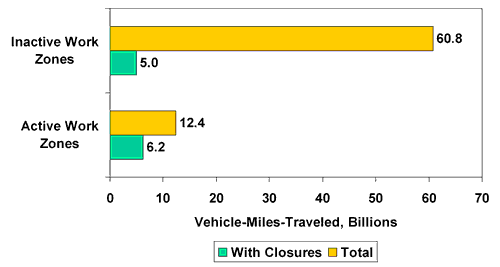
Slide 7. The Result…
Beetle Bailey cartoon. The first panel shows General Halftrack riding in a car and saying into a cell phone "Hello, Bureau of Missing Persons?" The second panel shows his car in a traffic jam stretching over hills and into the distance. Channelizing cones and work zone signs stating "Slow" and "Slow, work area" are on both sides of the roadway. His speech balloon shows "I'd like to report a missing road repair crew."
Real Life Adventures cartoon showing a road sign stating "2 left lanes closed for no reason whatsoever next 21 miles."
Slide 8. Speed Management in Work Zones
- Enforcement
- Speed control technologies
Slide 9. Enforcement considerations
- Realistic and "reasonable" speed limits
- Adequate coordination between DOT and enforcement agencies
- Labor availability
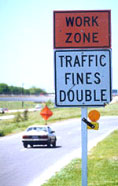
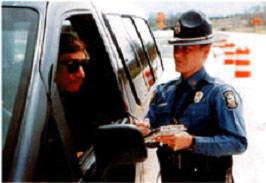
Slide 10. Enforcement
- Circulating: 2–3 mph lower
- Stationary: 3–13 mph lower
- Police Traffic Controllers: 2–14 mph lower
- Operation Hardhat: ???
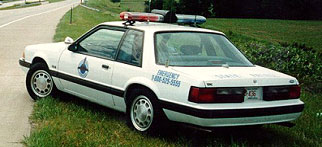
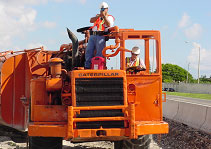
Slide 11. Work Zone Speed Control Technologies
- Enforcement surrogates
- Driver information/feedback
- Perceptual methods
Slide 12. Enforcement Surrogates
- "Dummy" vehicles: –
- Unmanned radar: 0–2 mph lower
- Remote enforcement: –
- Automated enforcement: –
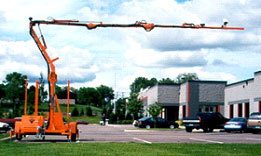
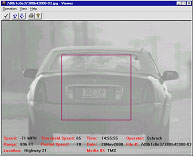
Slide 13. Driver Information/Feedback
- Changeable Message Signs (CMS): 0–2 mph lower
- CMS with radar: 0–6 mph lower
- Speed trailers: 2–10 mph lower
- CB Wizard: 0–2 mph lower
- Variable Speed Limits: 0–5 mph lower
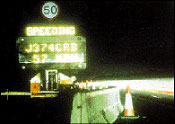
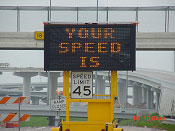
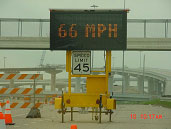
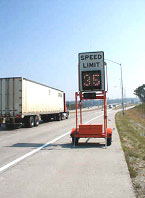
Slide 14. Perceptual Methods
- Rumble strips: 1–6 mph lower
- Transverse markings: 0 mph
- Narrowed lanes: 0–8 mph lower
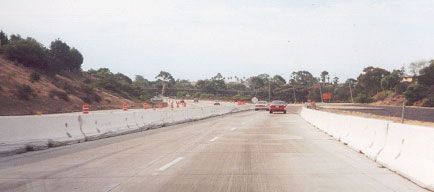
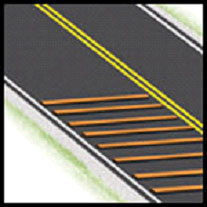
Slide 15. Congestion and Delay Management in Work Zones
- Increase work zone capacity and efficiency of flow
- Reduce traffic demands at work zone bottleneck points
- Communicate accurate estimates of delay and congestion expectations
Slide 16. "Get In, Get Out, Stay Out"
- 77% motorists prefer long-term repairs, even if delays are more significant
- Focus on longer-lasting materials, better construction methods, longer service life horizon
- Major constraint: money
Slide 17. Increasing Capacity
- Late-merge or dynamic merge control
- Moveable barrier systems
- Contractor accountability
Slide 18. Late Merge

Slide 19. Moveable barrier

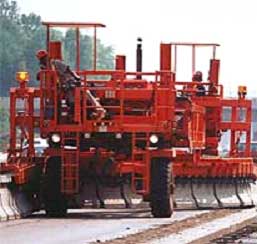
Slide 20. Contractor Accountability
- Arizona SR 68 (FHWA-HOP-04-032)
- $400k incentive pool
- Travel times exceeding 27 minutes reduced incentive pool
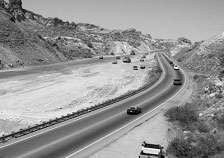
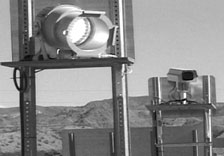
Slide 21. Reducing Traffic Demands
- Working at night and weekends
- Full roadway closures
- Portable Intelligent Transportation System (ITS) technology
Slide 22. Extent of Nightwork
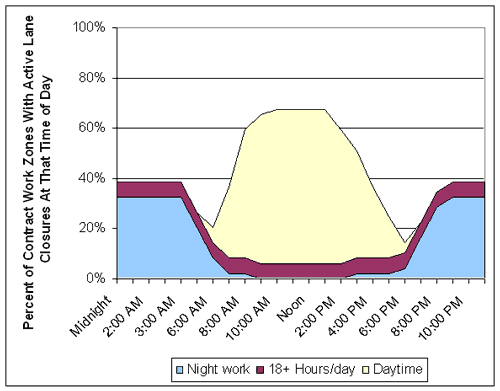
Slide 23. Concerns about Nightwork
- Efficiency, quality of work
- Safety
- Traveling public
- Workers
- Worker quality of life
Slide 24. Full Roadway Closures
- Roadway completely closed, traffic routed to alternative routes
- Increases work efficiency
- Eliminates traffic/work crew conflicts
- Requires high degree of coordination and contingency planning
- Impacts off-site difficult to predict and assess
Slide 25. A Broader Perspective

Slide 26. ITS Applications in Work Zones


Slide 27. Key principles
- Motorists should not be told something they already know
- Motorists should never be provided incorrect information (must maintain credibility)
- Motorist diversion thresholds: 10–20 minutes delay
Slide 28. Questions
Questions?
Slide 29. Transportation Management Plan
- Temporary Traffic Control (TTC) Plan
- Transportation Management Considerations
- Public Information Considerations

